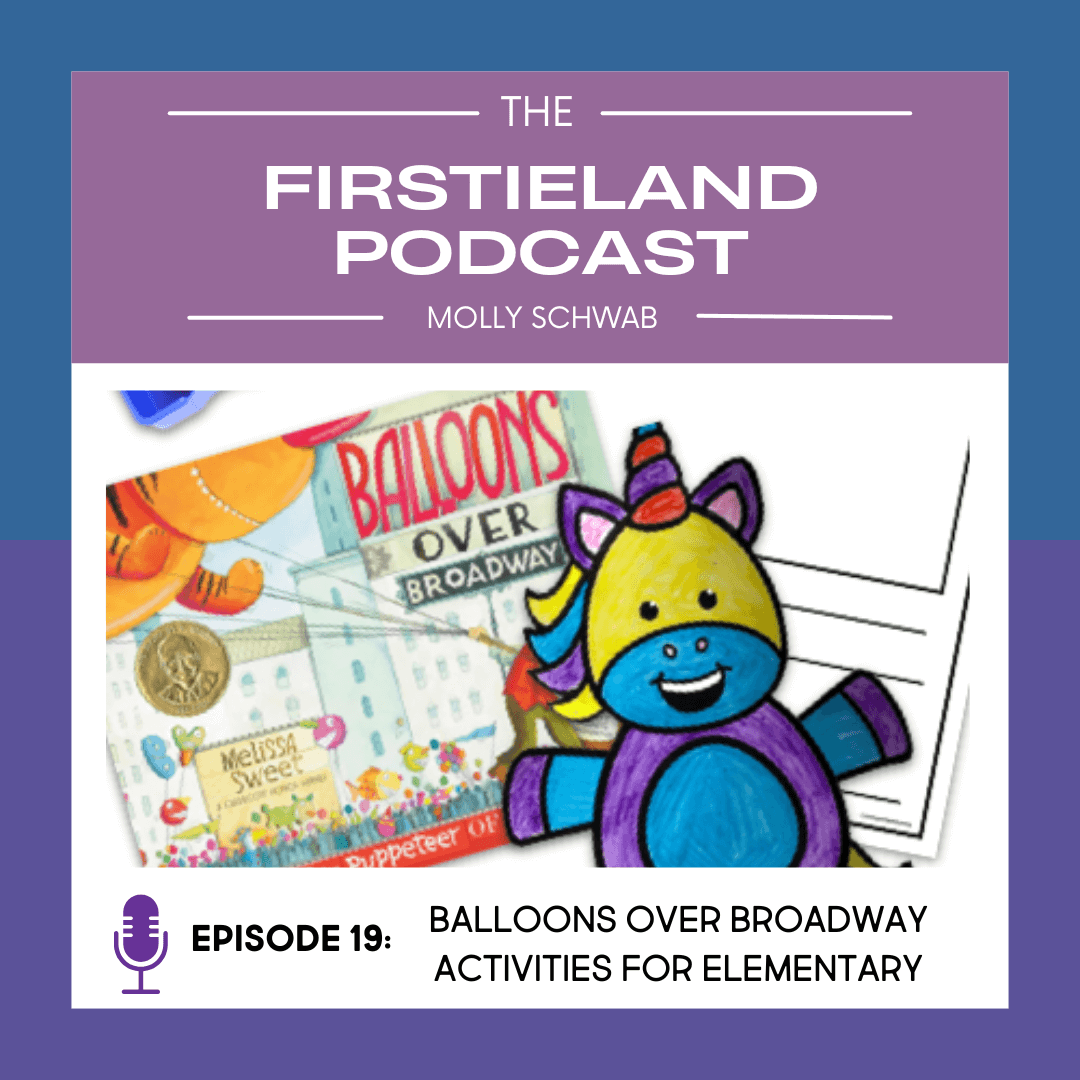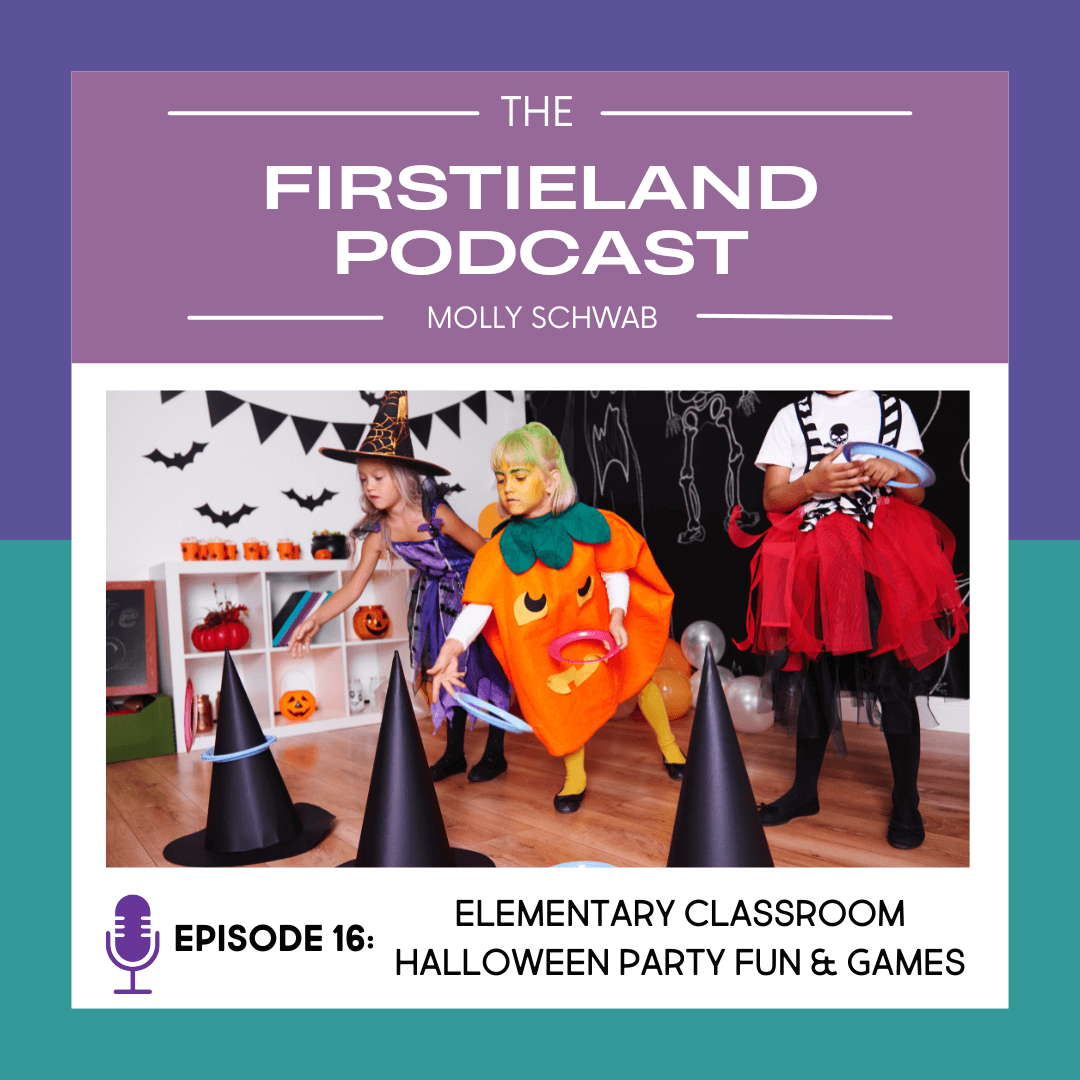[00:00:00] Hey friends. Welcome back to the Firstieland Podcast. I’m your host, Molly Schwab, and before we begin, I’d like to take a minute to give a shoutout to one of our listeners who left the nicest review.
This review comes from Nikkilou06, who said, “I absolutely love that you released this podcast at the perfect time. Summer is ending and it’s almost time to get back into the classroom. I love that the episodes are short and sweet but so informative. It was a great refresher and got me geared up and excited for the new year. I’m looking forward to more episodes.”
Thank you so much, Nikki, and I hope you’re having a great year! I really appreciate reviews like this—it totally makes my day. And if you’re enjoying the podcast, I’d love to hear from you too.
Alright, well, I don’t know what it’s like where you live, but fall is definitely upon us here in Ohio. There’s a little chill in the air and the leaves are starting to change colors. I dragged all my fall decorations up from the basement over the weekend, and now my house feels super cozy. I just love it.
So what does that have to do with today’s episode? About this time of the year, reality has started to set into the classroom.
[00:01:00] I hear lots of complaints from teachers that kids’ behaviors are out of control and they just aren’t sure how to get them engaged in class. I also hear teachers saying that they don’t have any time to do anything fun with their class. They don’t even have time to read to them.
And honestly, in my opinion, kids’ poor behaviors and the lack of fun in the classroom are totally related. When kids are unengaged, they’re gonna act out. They’re gonna talk, play, and not pay attention.
So today I’m gonna show you how you can use the fall season and something as simple as a few pumpkins to get kids reengaged and bring a little joy back to your classroom. Plus, I’m gonna show you how you can teach your regular reading and math curriculum and still have time to do all the things that I’m about to share. You ready? Let’s go.
[00:02:00] Hey there, I’m Molly from Firstieland, a former elementary teacher with over 30 years of experience in kindergarten and first grade. I’m here to help make teaching a little easier and a lot more fun. Whether you’re looking for the perfect read aloud, fresh writing ideas, or simple classroom tips, I’ve got quick, practical strategies you can use right away.
New teacher or experienced educator, there’s something for everyone in Firstieland. So grab your coffee and teacher bag—let’s get started.
Today we’re diving into one of my favorite fall topics, which is pumpkins. Most of the time when we think about kids and pumpkins, we associate them with Halloween and carving jack-o-lanterns. But today I’m gonna show you how you can take the topic of pumpkins and teach across the curriculum with the help of some of my favorite picture books.
[00:03:00] So let’s start with reading. Part of your first grade reading standards says that kids should be able to ask and answer key details about a story, describe the characters and setting, retell the major events, and compare and contrast the adventures and experiences of characters.
For me, the best way to cover those standards was always through a picture book. The key to having time to read aloud in your classroom is strategically choosing read alouds based on the standards you want to teach.
In October, I had lots of favorite picture books that helped me teach those literature standards. Creepy Pair of Underwear by Aaron Reynolds and The Good, the Bad, and the Spooky by Jory John were a couple that I loved. But one of my favorites was Spookley the Square Pumpkin by Joe Troiano.
If you’ve never read this book, it’s about a little pumpkin who’s square, and so he doesn’t fit in at the pumpkin patch. The other pumpkins make fun of him, and Spookley never feels like he belongs. Then one day there’s a big storm and it starts blowing the other pumpkins all over the place.
[00:04:00] Because they’re all round, they’re rolling everywhere—and some even roll right out through a hole in the fence. But since Spookley is square and has a flat bottom, he doesn’t roll. He scoots himself over to block the hole in the fence and saves all the other pumpkins.
The next day, when the farmer comes out to survey the damage, he finds this giant pile of pumpkins that had rolled around in the storm—and underneath all of them is Spookley, blocking the hole in the fence. Not only do the other pumpkins begin to appreciate Spookley for who he is, but the farmer does too. The next season, the farmer decides to grow pumpkins of all different shapes—not just round ones.
So Spookley the Square Pumpkin has a great message for kids, which is: you shouldn’t judge a book—or a pumpkin—by its cover. It’s perfect for teaching kids that sometimes the things that make us different are also what make us special.
[00:05:00] It’s a great book to use when you want to teach those literacy standards. You can compare and contrast characters in the story. You can talk about character traits—Spookley was brave, compassionate, friendly, and kind. It’s also a great book for retelling and excellent for discussing problem and solution.
Taking one simple storybook is the perfect way to teach all those literacy standards. You don’t have to do it with a boring worksheet. You can do it simply through discussion. And when you use a really cute story like Spookley, kids are going to be more engaged in your lesson.
Sometimes new curriculum asks teachers to teach literature standards using passages with no pictures—just text to read aloud. Honestly, that’s not developmentally appropriate for young kids. They need the pictures to help them follow along and stay engaged in the story.
Alright, let’s move on to math. How can you take that same story of Spookley and teach a math lesson? The obvious thing is shapes, right?
[00:06:00] Kids in kindergarten and first grade should be able to recognize the difference between two-dimensional, or flat, shapes and three-dimensional shapes. So you can do a lesson comparing a circle to a sphere, or a square to a cube. You can also compare 3D shapes like spheres and cubes—talk about what makes them different, how many sides they have, how many vertices. Shapes are a great math lesson to pull from this book.
In my room, I had pictures of pumpkins and the kids would measure them. I also found some cute little mini erasers shaped like pumpkins, and the kids used those to measure the pumpkin pictures. So there’s another way to use this book for math.
[00:07:00] Now let’s talk writing. Another one of my favorite pumpkin books is Pumpkin, Pumpkin by Jeanne Titherington. Not only is this book beautiful because of its watercolor illustrations, but it’s great because it shows the life cycle of a pumpkin.
It’s about a little boy named Jamie who plants a pumpkin seed and then cares for it. We see the whole process: seed, sprout, flower, little green pumpkin, and finally a great big orange pumpkin.
One way I used this book was to introduce procedural writing, or how-to writing. After reading the story, we’d start with a life cycle craft: a long sheet of paper divided into four sections. In the first, kids glued a real seed into brown “dirt.” In the second, they drew a green vine and glued yellow tissue for the flower. In the third, they painted a small green pumpkin with a Q-tip. And in the fourth, they painted a large orange pumpkin.
[00:08:00] After reviewing the life cycle of a pumpkin, we’d turn that into a how-to writing lesson. I’d model writing the steps using transitional words: first, then, next, last. I’d remind them about capitals, spacing, and punctuation. By October, most of my kids were able to write full sentences, so they were ready. For students who struggled, we differentiated by labeling the life cycle parts instead—seed, flower, vine, pumpkin.
That’s another way you can use pumpkins to create a really engaging writing lesson that kids actually want to do.
[00:09:00] Another favorite book is The Pumpkin Book by Gail Gibbons. If you aren’t familiar with this author, she writes excellent nonfiction books for kids. She takes a topic like pumpkins and really goes in depth in a kid-friendly way. This book shows the life cycle, how pumpkins are used in holidays like Halloween, and all the things you can make with pumpkins.
We used this book for graphing in math. I’d bring in pumpkin foods—pie, butter, donuts—and let kids taste-test. They were so excited! Then we’d graph our favorites as a class. We covered graphing standards and the kids loved it. They learned more from that one activity than they would have in a workbook, because they were engaged.
[00:10:00] So far, we’ve covered reading, math, and writing. Now let’s talk grammar and science. The Pumpkin Book is also perfect for science—teaching the life cycle, what pumpkins need to grow—and grammar, because it shows so many different varieties of pumpkins. It’s great for teaching adjectives and describing.
Here’s what you can do: go to a pumpkin patch and get 5 or 6 pumpkins in different shapes, sizes, and colors—white, green, bumpy, lumpy, striped, big, and small. Set them out and let kids touch and explore them. Then make an anchor chart shaped like a pumpkin. Kids help brainstorm adjectives—bumpy, orange, tall, slimy once it’s carved, etc.
[00:11:00] Afterward, they make their own paper pumpkin and write descriptive words around it. It’s a fun, hands-on way to teach adjectives, and kids love it.
Finally, let’s finish with science. After a week of pumpkin activities, on Friday I’d set up pumpkin investigation stations. Kids rotated to weigh pumpkins, measure them, and test sink-or-float. They recorded observations in little journals. It was a fun way to wrap up the unit and sneak in more science and math.
[00:12:00] Now you might be thinking, “I don’t have time for all this.” I get it—I had a rigorous reading and math curriculum too. But I carved out 30–45 minutes in the afternoon for units like this. We’d do one or two pumpkin activities each day. Afternoons are tough—kids are tired—so hands-on learning keeps them engaged and reduces behavior issues.
[00:13:00] So just to recap: if you’re struggling with behaviors from bored, unengaged kids, simple units like this pumpkin unit can help. Use picture books to drive your lessons, integrate reading, writing, math, and science, and make learning hands-on and fun.
If you want to try it, I’ll leave links to the pumpkin activities and books in the show notes. I hope this episode helps you think outside the box to reengage your students and bring joy back to your classroom.
[00:14:00] Thanks so much for tuning in. I hope you’re walking away with some great tips you can use right away. Be sure to hit follow or subscribe so you never miss an episode. And if you’re enjoying the podcast, I’d love it if you’d leave a review. You can find the show notes and links for everything mentioned in this episode at Firstieland.com.
I’ll see you next week in Firstieland!











